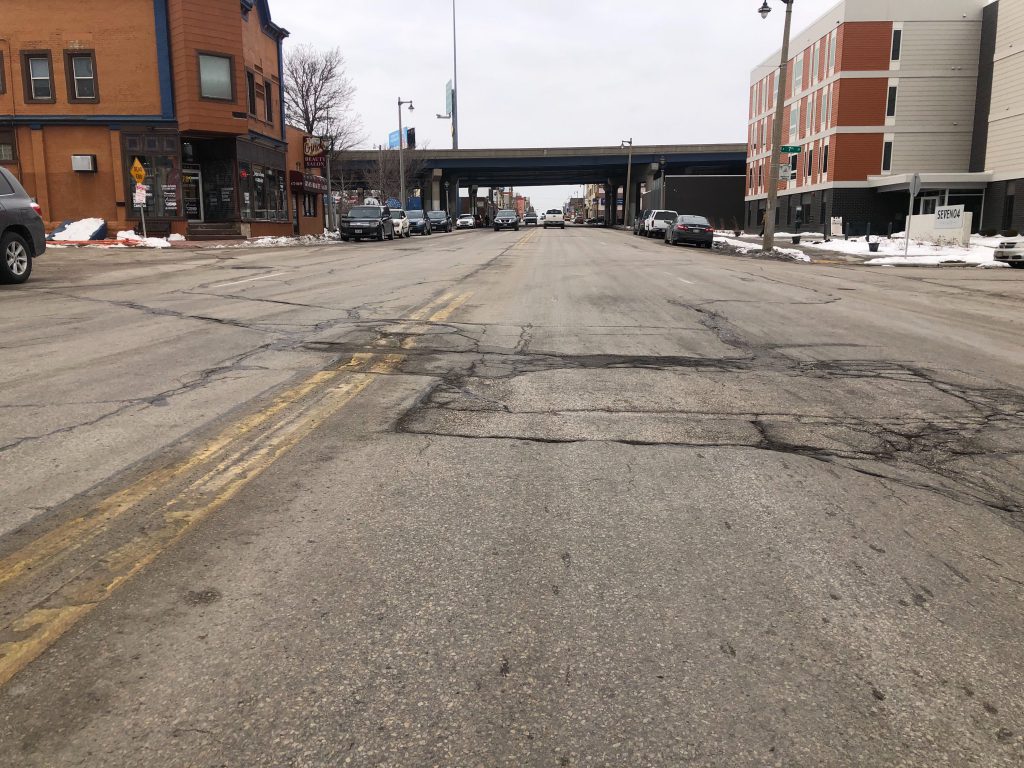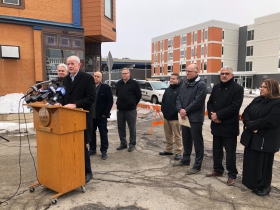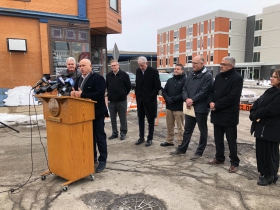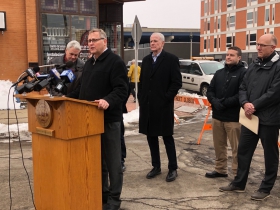Should National Avenue Rebuild Include Plans for Streetcar?
Alderman Bauman floats idea as strategy to save money if future extension is built.
The Department of Public Works is moving forward on design work to rebuild W. National Ave. from S. 1st St. to S. 39th St.
Construction work is expected to start in 2026 on the state-backed, $25.2 million project. But one council member is already looking beyond that to what could come next.
DPW major projects manager David Tapia said design work hadn’t proceeded to that point yet, and that it wasn’t exactly clear where a future streetcar line would be located in the roadway.
“There are probably streetcar tracks buried under that entire length of road. Double tracked on the centerline, exactly where it’s supposed to be,” said Bauman. Many street reconstruction projects in Milwaukee involve removing tracks that were paved over more than 50 years ago. Tapia said “ground-penetrating radar” revealed that the streetcar tracks were still there in National in many locations.
Bauman said National Avenue was a logical spot to bring the streetcar back given its high population density, varied housing types, and mix of commercial and industrial businesses. It also provides a route to a major destination. “That is your back door connection to [American Family Field[ from Downtown,” said the alderman. “I think it would be a huge boost for those neighborhoods.”
Clearing a pathway for a future streetcar could save millions of dollars if a future extension is built.
“When you’re ripping out the street down to the subgrade, this is the opportunity to at least think ahead like we did with the St. Paul bridge,” said Bauman. The bridge over the Milwaukee River was rebuilt with space for streetcar rails before the full streetcar project was approved.
The council allocated $250,000 from a tax incremental financing district to do preliminary engineering work and identify a preferred route on an extension from the Historic Third Ward south to the area near W. National Ave. and S. 1st St. Bauman and Tapia agreed Thursday that S. 1st St. to W. National Ave. was the likely corridor.
When the rebuild was first announced in February 2020, Area Alderman Jose G. Perez and then-DPW Commissioner said the project gives the city to opportunity to build a street that serves all users, not just motorists. The project includes rebuilding, and potentially expanding, both the roadway and sidewalks.
The committee unanimously endorsed a non-streetcar-related amendment to the project plan that increases the design cost $118,600, with the city paying $29,650 of the increase. The city is to pay only $1.57 million of the project’s costs because the street is technically Wisconsin Highway 59.
The Need For Outreach
Perez is pushing for the city to have a robust outreach effort to businesses and residents in the corridor.
“As soon as this hits the airwaves in any form all the businesses get so nervous about what the construction is going to mean,” said Perez.
Tapia said the city was hiring a consulting firm to augment the city’s in-house capabilities. It would also be using the Social Pinpoint software platform to allow stakeholders to tag areas of concern on a map or identify other issues.
Ald. Russell W. Stamper, II said his experience is that people need to know businesses are still accessible. “The key was getting those signs up,” he said of a project in his district. DPW installs free-standing, “open for business” signs, often approximately six feet tall, that let people know what places are accessible and how to get to them.
Legislation Link - Urban Milwaukee members see direct links to legislation mentioned in this article. Join today
If you think stories like this are important, become a member of Urban Milwaukee and help support real, independent journalism. Plus you get some cool added benefits.
More about the Milwaukee Streetcar
For more project details, including the project timeline, financing, route and possible extensions, see our extensive past coverage.
- FTA Tells Milwaukee to Crack Down on Fare Evasion — Even Where Fares Don’t Exist - Graham Kilmer - Dec 12th, 2025
- Alderman, State Allies Seek Federal Help to Kill the Streetcar - Jeramey Jannene - Oct 28th, 2025
- Streetcar Service Suspended Following Truck Crash - Jeramey Jannene - Oct 21st, 2025
- One Alderman’s Quest To Defund The Streetcar - Jeramey Jannene - Oct 18th, 2025
- Another Streetcar Collision - Jeramey Jannene - Jun 27th, 2025
- Streetcar Hit By Apparent Red Light Runner - Jeramey Jannene - Jun 16th, 2025
- Streetcar Will Run On Consolidated Route During Summerfest - Jeramey Jannene - Jun 11th, 2025
- City Hall: Milwaukee Must Replace Failing Streetcar Switches - Jeramey Jannene - Feb 24th, 2025
- Streetcar Confronts Limited Funding, Operations Challenges - Evan Casey - Jan 22nd, 2025
- Council Kills Streetcar’s ‘Festivals Line’ - Jeramey Jannene - Jul 31st, 2024
Read more about Milwaukee Streetcar here
Transportation
-
Congestion Pricing Cuts Air Pollution in New York City
 Dec 14th, 2025 by Jeff Wood
Dec 14th, 2025 by Jeff Wood
-
FTA Tells Milwaukee to Crack Down on Fare Evasion — Even Where Fares Don’t Exist
 Dec 12th, 2025 by Graham Kilmer
Dec 12th, 2025 by Graham Kilmer
-
Will GOGO’s Bus Service Ever Get Going?
 Dec 9th, 2025 by Jeramey Jannene
Dec 9th, 2025 by Jeramey Jannene


























Absolutely.
Not only is this a stone’s throw from AmFam Field, but 39th is the the border with West Milwaukee, the eastern edge of the old Komatsu plant that is being zoned for redevelopment.
Perhaps the Brewers and others will lead development of a new sports district?
Should The Hop be expanded?
Answer: Yes, here is why:
1) The Hop has proven itself to be a capable public transit system on its small starter route. It has operated safely and adjusted its service dynamically to changing conditions. It operated during polar vortex conditions, in our four-season weather, in mixed street traffic, and during the global Covid-19 pandemic.
2) The Hop’s ridership grew in its first full calendar year of operation, 2019, and showed great ridership levels and interest before the Covid-19 pandemic. The pandemic caused a plunge in public transit ridership worldwide. The Hop’s service on the Main Line relies heavily on downtown destinations, many of which were shuttered during the pandemic. The Hop’s service schedule was reduced during the pandemic. The Hop’s ridership has been recovering.
3) The Hop’s award-winning, modern, electric-powered, hybrid (overhead or battery power options), emissions-free, ADA-compliant, level-boarding, two-door boarding, American-made vehicles as well as its support team and operators have proven their ability to operate safely and well along the starter route and adjust to technical challenges and use innovative short routes to continue service during outages, for example, of the St Paul Avenue Bridge.
4) The Hop’s characteristics as rail urban transit–modern streetcars–are unique in the state (Kenosha has historic streetcars) and unique in Milwaukee in the 21st century. Streetcars are used in hundreds of cities throughout the world and are being emphasized as a transit mode that addresses climate change and provides accessible, pedestrian-friendly (quiet, emissions-free) transit to walkable urban neighborhoods. The Hop’s Liberty modern streetcar can draw power from the overhead wire and the pantograph or onboard lithium-ion batteries. This allows for reduced construction costs and lengths of the route on which no overhead wires need to be constructed.
5) The Hop’s fixed-track nature is not a detriment, but a catalyst for development. Observations have shown that development occurs near streetcar stations and that more efficient land use results from streetcar stops. The Hop’s Main Line has seen many developments during its operation, including the completion of the BMO Tower, the Huron Building, Tru by Hilton, Holiday Inn Express, Home2 Suites by Hilton, Cambria Hotel, and the Dwight and Dian Diercks Computational Science Hall at Milwaukee School of Engineering University. The construction of The Ascent began in the fall of 2020 and The Couture began in 2021. Notably, the buildings listed here provide more productive use of the urban land, as many replaced automobile storage areas.
6) The Hop’s fixed-track nature is not a detriment, but a benefit for pedestrians and the urban fabric of walkability because it provides a reliable, quieter, emissions-free, known path of travel that allows for the vehicles to closely integrate with pedestrian areas. The best example of this can be found at the Milwaukee Public Market stops where people and streetcars co-exist side-by-side. The Hop reknits the walking and transit fabrics of the city lost during the 20th century due to automobile dominance.
7) The Hop has generated revenue through sponsorship and advertising and has started to deploy CityPost Smart Kiosks that come “at no cost to the city, as Smart City will own and maintain the kiosks throughout the 10-year agreement while providing the city a share of the revenue generated through the platform” (Urban Milwaukee, February 20, 2020). This is an excellent example of a public-private partnership that can benefit both. The Hop’s vehicles and information kiosks can serve community needs for health and other public information.
8) The Hop provides health benefits through its emissions-free operation so that people near the vehicles don’t have to breathe fumes. It provides support for walking and the streetcar as a basis for personal transportation. It provides access to health services, grocery stores, a pharmacy, and parks. The Hop fits into Milwaukee’s plans for addressing climate change and environmental issues (City of Milwaukee, “Environmental Collaboration Office (ECO)”).
9) The Hop provides equity benefits for people who need to have level-loading, smoothly-operating, accessible transportation. The Hop’s big, double doors open in way that doesn’t require a long delay in vehicle loading. The Hop’s service to people who don’t have cars, have a disability, or can’t drive, gives access to municipal services (City Hall) and destinations to meet needs like grocery stores, pharmacy, and medical offices. The high-quality transit experience streetcars offer reknits the urban landscape around people and can start to rectify imbalances due to inequities in transportation options.
10) The Hop provides livability benefits by offering an alternative means of transportation other than automobile travel. It brings a visible, unique, reliable form of transportation to visitors and residents alike. The streetcar utilizes the curb space for bringing people to and from destinations much more efficiently and in a higher capacity than an individual vehicle or a bus. The Hop highlights businesses along the route through great visibility from riders to the businesses through the large windows.
11) The Hop provides prosperity benefits by its status as public infrastructure, public transportation, and rail transportation. Public transit benefits include energy and environmental benefits, economy and employment benefits, and health benefits (American Public Transportation Association). Rail benefits include “less traffic congestion, lower traffic death rates, lower consumer expenditures on transportation, and higher transit service cost recovery than otherwise comparable cities with less or no rail transit service. This indicates that rail transit systems provide economic, social and environmental benefits, and these benefits tend to increase as a system expands and matures” (Litman, “Rail Transit In America: A Comprehensive Evaluation of Benefits,” 2020). The prosperity of private enterprise itself depends on public infrastructure. Public transportation, in general, is never built to make a profit but to give public benefits and support free-market enterprises. The Hong Kong Mass Transit Railway (MTR) does make a profit, but it does so using a “transit + property” model where the MTR operates real estate on its service corridor and makes profits based on the added land values due to rail service. Our system of public infrastructure + private enterprise allows the benefits to accrue to the community and the private sector. Hence, our public infrastructure itself needs financial support for its funding since it allows the benefits it creates to go to the people, not to itself, nor to a government-run property manager.
12) The design of the streetcar corridor reveals a path for developing urban areas to their potential for walkability, environmental benefits, equity, and economic growth. The Hop’s goal has always been for service beyond the Main Line. Expanding the streetcar line by even one stop adds significant destinations because the additional area encompassed grows by the square of the distance around the additional station. Expanding the Hop expands the health, equity, livability, and prosperity of our community.
Note that at present, the streetcar’s net operating cost is less than 1/2 of 1% of the city’s budget. It gives outsized benefits for that price.
John D, thank you for your continued advocacy of streetcar expansion. The adjacent real estate development is undeniable. We need tax base growth and we are getting just that.